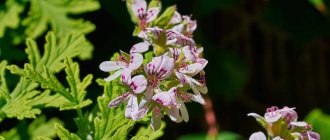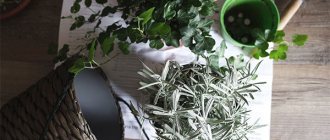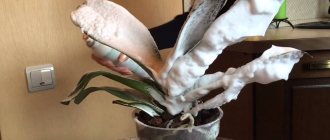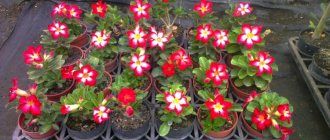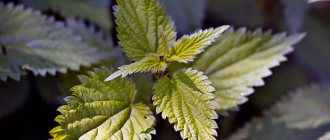- Sphagnum moss as soil drainage
- How to use shells for drainage
- Optimal mode for microgreens on the windowsill
All Collapse
When planting/transplanting potted plants and tubs, experienced flower growers and gardeners must pour drainage into the bottom of each planting container. It is especially important to fill the bottom of the pot with indoor flowers with a layer of permeable material to quickly remove watering moisture if there are no drainage holes in it.
What is expanded clay?
This is a natural material made from clay or shale, fired in a kiln at a temperature of 1200 °C. Contrary to popular belief, there is no division into construction and floral expanded clay - they are the same material.
On sale you can find granules of large (2–4 cm in diameter), medium (1–2 cm) and small (0.5–1 cm) fractions, as well as expanded clay sand (less than 0.5 cm). The granules, smooth on the outside, have a porous structure on the inside - they weigh little, do not interfere with air exchange and are able to accumulate and release moisture.
Advantages and disadvantages
Expanded clay is light and porous brown granules, and it is made mainly from clay. At high temperatures it is fired in special furnaces, as a result of which the material becomes smooth on the outside and almost hollow on the inside. Expanded clay granules have different sizes - from 5 to 40 mm in diameter.
You can purchase dried clay either in bulk or packaged in bags.
Ready-made expanded clay granules have many positive qualities. Let's see why gardeners love them so much:
Expanded clay has almost no disadvantages, and those that exist are associated more with the insulation of apartments and houses rather than with outdoor use. For example, wet material takes a long time to dry, not wanting to give up moisture. When used in apartments, this drawback is felt acutely, but on the site it should not create problems, unless the paths are wet for a couple of days. A more significant disadvantage is the excessive dust formation.
This means that when scattering expanded clay on roads and flower beds, you need to wear a respirator or mask, otherwise dust particles may get into the respiratory tract.
Once scattered, the dust will quickly settle and the material will no longer pose a health hazard.
Expanded clay granules can be of several types. All of them are used in the landscape design of the site.
Gravel is most often used for filling paths.
The oval smoothed shape contributes to the decorative appearance and comfortable movement of the owners of the site.
This type of expanded clay is used in flower beds and flower beds, since walking on sharp stones is not very convenient.
This material is sometimes used to replace regular sand on the site, decorating flower beds with it.
Application of expanded clay
Bottom drainage
The material will protect the roots from stagnation of moisture, absorb excess and slowly release it into the external environment. This has a particularly positive effect on the condition of moisture-loving plants that require frequent watering: the soil will not become sour, and in the intervals between the supply of moisture (without extreme intervals) the flower will not suffer from drought.
The recommended thickness of the lower expanded clay drainage is from 2 cm, depending on the depth of the pot.
Upper drainage
By accumulating water, the granules prevent its rapid evaporation from the surface of the substrate. If there is no one to entrust with watering the flowers during a short-term vacation, the upper drainage made of expanded clay will help the moisture stay in the ground longer. However, with regular heavy watering, it is better to abandon this idea - the soil may turn sour.
Salts contained in tap water often settle on the surface of the substrate - alkalization of the soil occurs. For this reason, it is recommended to periodically change the top layer of soil for indoor plants. However, when using expanded clay, salts accumulate on the shell of the granules - it is easier to replace them.
Another advantage is protection against overheating in hot weather. Breathable expanded clay heats up in the sun more slowly than the ground.
The recommended thickness of the upper drainage made of expanded clay is at least 1 cm.
As part of the earth mixture
Fine-fraction expanded clay is often used as a loosening agent for heavy soils. It promotes better air exchange and increases the hygroscopicity of the substrate, protecting the roots from rotting in case of excessive watering. Manufacturers often include expanded clay in the substrate for cacti and other succulents. Collectors have not made such a decision, but it has its own logic: expanded clay is covered with a hard ceramic shell - it will easily absorb a small excess of moisture, but will release it less actively.
Hydroponics
When growing without a substrate, the main task is to provide the optimal amount of nutrients to the root system. Expanded clay is used as a medium that conducts water and fertilizers dissolved in it to the roots. It does not rot, does not mold, and performs well in intermittent flooding systems, in systems with frequent watering cycles, and even with the pump constantly on. Properly prepared expanded clay is chemically neutral to the ions of the nutrient solution and is suitable for reuse.
Gardening
Granules and expanded clay sand are used as mulch to protect the soil from mold in wet weather and retain moisture in hot weather.
Landscape design
Colored expanded clay decorates paths and flower beds. The dyes used in production are safe for plants and do not affect the quality of the soil.
Air humidification
In winter, many indoor plants suffer from dry air. If you don't have a humidifier, you can improve the situation with expanded clay. Soak the granules for several hours, fill wide flat containers with them, pour water into them and place them on the windowsills. Pots with plants can be placed directly on the expanded clay layer.
Drainage and its purpose
Many houseplants require a soil composition that provides approximately 50% solids, 35% water and 15% air. Only a properly laid drainage layer will help recreate optimal conditions for growth and flowering.
The problem with lack of drainage is that overwatering displaces air, which is vital for flowers. The lack of oxygen in the soil provokes the development of pathogenic bacteria. The root system begins to rot and the plant withers. The drainage layer ensures the outflow of excess moisture and good breathability.
Indoor plants and drainage in pots
How to replace expanded clay?
For drainage, you can take stones (pebbles, crushed stone, gravel), coconut fiber and polystyrene foam. They do not accumulate moisture, but also do not affect the pH of the soil. Crushed brick and clay shards, like expanded clay, have an alkaline reaction, which should be taken into account when preparing a soil mixture for the needs of a particular plant. Pine bark is sometimes used, but it is less durable. If the goal is to prevent rapid evaporation of moisture, sphagnum moss can be used as top drainage.
Coarse sand, coconut fiber or foam chips are suitable as a substrate loosening agent If you need a material with moisture-storing capacity, pay attention to perlite and vermiculite - they have greater moisture capacity than expanded clay and have a pH value close to neutral.
Source
What materials are suitable for arranging drainage?
Natural and artificial solid materials that are resistant to moisture can be used as drainage . Expanded clay, gravel and vermiculite are most often used, but there are also unexpected solutions.
Let's look at the characteristics of each to understand which drainage is better.
Crushed stone, pebbles and gravel
Common pasture material that is easy to obtain yourself. All three types pass water well, but, perhaps, this is their only advantage.
If we talk about the disadvantages, then we include the weight of the materials: when using them in large containers, it will be difficult to lift such a pot .
All these materials conduct heat well, so they are not recommended for use for flowers overwintering on window sills . The pebbles will absorb the cold, which will negatively affect the roots of the plant, and it may get sick.
Vermiculite and perlite
Ready-made materials that are sold in packaged form in flower shops. Initially, it is an additive to the soil, which prevents its acidification and mold formation, but can also be used as a separate material for drainage . Other characteristics:
If they have a drawback, it is their high cost.
Expanded clay
Refers to popular types of drainage. It was originally created as insulation in the construction field. Made from foamed and fired clay. It varies in fraction sizes (fractions of 5–20 mm are suitable for drainage).
Expanded clay absorbs moisture and, when necessary, releases it . Added to the substrate, it maintains normal water balance in the soil. The advantages of the material include:
Sold in construction and flower shops.
Expanded clay is sold in flower shops, the packaging of which states that it is enriched with microelements. It is difficult to verify how true this is. Let's wait for feedback from those who have used it.
Broken brick
If you have the opportunity to collect broken red brick, it will perfectly serve as drainage . This brick is made from clay, which means it has properties similar to expanded clay.
Ceramic shards
By collecting fragments of broken ceramic pots, dishes and other items, you can stock up on drainage. They are light in weight, have good drainage properties, do not absorb moisture, and do not contain chemicals .
The main thing is to be careful when collecting and laying them: do it with gloves so as not to get hurt by sharp chips.
Styrofoam
An easily accessible material that can be found in packaging for household appliances and after insulating walls during construction or renovation.
Foam plastic is a synthetic material obtained by foaming plastic. However, it is absolutely safe for plants , since it is sterile and resistant to infection by fungus and other harmful microorganisms.
Foam drainage does not absorb moisture, but does not release it either . If you want to improve its moisture transfer properties, you can mix pieces of foam with hydrogel.
As for the disadvantages, it is worth mentioning that plant roots can freely grow into the foam, which will create difficulties when replanting them .
In addition, the material weighs almost nothing. It is not suitable for plastic containers, but it is ideal for large ceramic pots, since it will not add any weight to them.
Charcoal
How to replace expanded clay or broken brick? There is another material for drainage that is generally available - charcoal.
Having undergone specific heat treatment, it is sterile, has a porous structure, and is neutral in acidity. Moreover, charcoal acts as an antiseptic, preventing diseases of the root system .
The disadvantage of charcoal as drainage is considered to be its low weight. In addition, it gets very dirty.
Sphagnum moss
Environmentally friendly, well absorbing and releasing moisture, pure sphagnum is ideal for organizing a drainage layer .
You can collect it yourself; the best time to collect it is autumn. Moss grows in the forest, in places with marshy soil. It rarely comes to stores.
Before placing the moss in a pot, it is recommended to soak it in warm water (45 °C). Sphagnum keeps well in the refrigerator, so it can be collected for future use.
Sea or aquarium stone
Pet stores sell aquarium soil consisting of small sea pebbles. An alternative replacement for gravel and crushed stone , and you don’t have to collect it yourself. The only thing that confuses me is its price: it is quite high.
Application of expanded clay in floriculture
Expanded clay is recommended to be used not only as drainage, but is also recommended to be added to the soil as a leavening agent. The opinions of flower growers on the advisability of using expanded clay are divided.
Some are convinced that this is an essential component of the soil and cannot be done without it, others consider it toxic, and due to its structure, it also absorbs huge amounts of water, which forms a swamp at the bottom of the pot in which pathogenic microflora begins to develop.
What is it really? Let's try to figure it out.
Why are drainage holes needed?
Everyone knows where to pour drainage material. However, before filling the bottom of the pot with drainage, you need to make sure whether there are holes in it and what diameter they are. Drainage holes allow excess liquid to flow freely into the pan .
If there are large holes in the pot and there are a lot of them, then add a low layer of drainage consisting of large fractions so that the elements do not spill out.
It’s even better if you lay the material in two layers, placing large fractions at the very bottom, and sprinkling them with small particles on top.
How to use drainage for containers with small holes? Obviously, small fractions cannot be laid (they will simply clog the holes). Use expanded clay or large pebbles for drainage.
The number of holes and their size are selected individually for each plant . So, for cacti, succulents and orchids, the material of the pot should be porous and the holes should be small so that moisture leaves quickly.
Flowers accustomed to high humidity need dense soil and 2-3 small drainage holes .
Expanded clay as drainage
First, let's define what drainage is? This is the presence of drainage holes in the bottom of the pot, baking powder in the soil and only after this a layer of expanded clay at the bottom. When using expanded clay, it is assumed that it will help remove excess moisture during watering. Undoubtedly, if the two previous conditions are met.
Let's consider the option when there are not enough drainage holes in the pot, or they are too small in diameter. In addition, when planting, a dense, heavy substrate is used, which clogs the holes in the pot. Over time, this substrate will settle, become compacted, and make it even more difficult for air to reach the roots. In this case, a layer of expanded clay at the bottom will help save the situation, but only partly. It will prevent the soil from clogging the drainage holes and give at least a minimal chance for air to get through to the roots.
It’s a stretch, but we can say that a layer of expanded clay at the bottom of the pot improves aeration.
As for moisture absorption and the ability to quickly absorb, retain and release moisture, one can doubt it. After all, as we remember from the experiment, expanded clay does not absorb as much moisture as we would like, moreover, during the experiment it took a certain time to absorb moisture, but when watering this time will not be available. The water will quickly pass through the substrate, some will be absorbed by the soil, and the rest will flow into the pan; only a small part of it will reach the expanded clay. An exception is that if you do not drain the water from the pan after watering, then the bottom layer will remain wet, which will create ideal conditions for the development of pathogenic microflora.
I would like to note that it is the padding polyester that some gardeners use to lay the bottom of the pot that can absorb a large amount of moisture; it is this that creates a swamp, making it difficult for air to reach the roots of the plant.
Expanded clay on the ground surface
The presence of expanded clay on the soil surface harms the plant:
Expanded clay in soil 2 compositions
There is no need for the presence of expanded clay in soil composition 2:
Source
Errors in the manufacture of drainage
Flower growers often make mistakes when making drainage:
- Do not use fine sand, which will clog the water drainage holes over time.
- You should not use large fractions, which do not retain moisture at all, and it immediately flows into the pan.
- Do not use natural materials that tend to rot, such as sawdust or tree bark. The rotting process often provokes plant diseases.
- It is not advisable to use marble chips. This material, when interacting with water, changes the acidity of the soil.
- It is not recommended to use materials with sharp edges: they can damage the root system of the plant.
How is expanded clay used for plants?
Expanded clay is pellets. They can be round or cylindrical. The material is obtained by processing clay at a high temperature of 1200 0C. Depending on the size and shape of the pellets, expanded clay gravel, crushed stone and sand are distinguished. The main area of application is construction.
The material is used for the production of slabs and porcelain stoneware. It is used as a filler to insulate foundations and floor coverings. Expanded clay is actively used for growing plants. What characteristics attracted plant growers? How to work with this material?
Proper drainage of house plants
The health and even life of the green pet ultimately depends on how correctly the gardener organizes the drainage system. It is important to pay attention both to the planting container itself and to the height and composition of the drainage layer. Let's look at these nuances in more detail.
Drainage layer height
The height of the layer, the main purpose of which is proper drainage, depends on both the plant and the dishes chosen for planting.
As you know, bowls for plants can be of very different shapes, from narrow and tall to wide and low. The height of the drainage directly depends on the shape of the container. So, in tall narrow pots, the soil dries out slowly; therefore, in containers of this type, the drainage layer should be quite voluminous (4-6 cm). Low and wide bowls, on the contrary, require a large surface area of the soil through which air exchange occurs. Therefore, the drainage in this case may be slightly less (1.5-2 cm). In standard bowls, the height and diameter of the upper ring of which are the same, the usual size of the drainage layer is about 3 cm.
The above dimensions apply only to medium-sized containers, so allowance should be made for the capacity of the planting container. In general, the height of the drainage layer in tall and narrow pots should be 1/3 or 1/4 of the total volume, in low and wide ones - 1/8, and in standard ones - 1/5 or 1/6.
The height of the drainage layer depending on the size of the pot
The material from which the flowerware is made is also important. It is known that unfired clay has a porous structure that allows air to pass through. In such pots, the plant's roots will receive a sufficient amount of oxygen, so the drainage layer may be slightly lower. Plastic, metal, glass, glazed ceramics are airtight, which should be taken into account and compensated for by a significant drainage height.
Another factor that you need to pay attention to is the number and diameter of the drainage holes in the flower container. The more there are and the larger the diameter they have, the lower the drainage layer should be. The size of the fractions of the drainage layer should also be taken into account - they should not spill through the holes.
The best option would be a two-layer drainage device: the bottom layer is coarse-grained, the top is fine-grained. Such a system perfectly passes excess liquid without clogging the drainage holes and without spilling out.
The volume of the drainage layer also depends on the indoor plant being planted. The homeland of some of them is the rainy tropics, others are dry deserts, and there are those who came to our homes from wet swampy places. That is why, before planting, it is important to find out in what natural conditions this or that representative of the kingdom of Flora grows.
As a rule, residents of deserts and other regions with hot and dry climates (cacti and succulents, some types of palm trees) need good drainage. A low drainage layer is suitable for plants in marshy areas and epiphytes if a special breathable soil consisting mainly of bark is used.
Main characteristics
Expanded clay pellets are porous. They have a lot of air. The material is introduced to maintain the soil in a soft state. Both gravel and crushed stone are used. Expanded clay supports normal gas exchange processes for plants.
It is used both in garden beds and for preparing soil mixtures for seedlings and for growing indoor flowers.
The pores of crushed stone can fill with water. The material is hygroscopic. Water is retained in the pores for a long time. Expanded clay releases moisture to plants gradually, maintaining a constant water balance in the soil. This is especially important for moisture-loving flowers and garden crops.
Properties and advantages of expanded clay
This material has deservedly gained wide popularity not only among builders, but also farmers and landscape designers. What are the main advantages of expanded clay?
- High strength. Expanded clay is durable, so it can be used repeatedly.
- Good sound and heat insulation.
- A light weight.
- High frost resistance (25 cycles or more) and fire resistance .
- Chemical inertness and acid resistance . Expanded clay is resistant to chemically aggressive environments.
- Low water absorption (no more than 20%). Expanded clay prevents moisture from evaporating and thereby controls the water balance of the plant.
- Environmental friendliness of the material. Expanded clay does not contain harmful additives, so it is safe for health.
- Presentable appearance. Small pebbles of expanded clay fit perfectly into the design of any flower garden. They look natural, are barely noticeable and do not overshadow the decorative plants.
- The optimum ratio of price and quality . The material is already inexpensive, but if you don’t throw it away after the first use and reuse it, then it will cost mere pennies.
Areas of use
Expanded clay is purchased at retail outlets where garden products are sold. It is in packages. They are usually labeled as "plant drainage" or floral drainage. Usually this is prepared crushed stone or gravel. It has already been washed and normalized for acidity.
It can be immediately used for indoor plants, hydroponics or in the garden plot. The manufacturer usually reports the pH of the material. The following companies represent expanded clay on the market:
The manufacturer sells drainage and pellets of a certain size. Plant growers do not need to select expanded clay and sort it by diameter. The material can also be purchased at a hardware store. At the same time, they pay attention to factions.
Material with grains up to 3-5 mm is sand. It is used in construction, as fillers for warm mortars. In plant growing, it is introduced to improve the soil. You can sow in sand, but this is rarely done. Sand is difficult to normalize for acidity. It must be soaked in water and reagents introduced. Then, it is sifted, but the granules are too small. For sowing it is better to use vermiculite or perlite.
Expanded clay gravel is round granules of a terracotta shade. Its scope of use is more extensive.
Pellets of 5-10 mm are used both in construction and in crop production. Expanded clay is used for aquariums. The material is laid as drainage for alpine slides during the construction of garden paths. It is introduced into the soil to maintain softness. Gravel is used as a decorative material.
Expanded clay 10-20 mm is actively used by home plant growers and gardeners. It can be introduced into the soil so that it retains moisture well and is loose. It is used to prepare drainage for indoor plants when growing vegetables on the balcony.
In medium-fraction gravel, seedlings are rooted and flowers are grown. This is a good substrate for hydroponic plants. The material is light. It does not weigh down the structure. The pellets are placed in flower pots, in the garden under trees and shrubs for mulching.
Material with granules of 20-40 mm is used mainly in construction for insulating roofs, floors, and foundations.
Gardeners consider it for drainage of trees and large shrubs. The pellets are large, they are inconvenient to place in a flower pot and introduce into the soil mixture, but they can be laid on top of the soil to maintain moisture in it. They look beautiful in a pot or in the garden.
For indoor plants
Home growers use expanded clay of fine or medium fraction. Rooting of cuttings is carried out on it. Orchids, palm plants, roses, and moisture-loving flowers develop well on the substrate. The substrate must be prepared.
- It is washed and kept in water for 3 days. Then change the water and check the pH. If the indicator is increased, then soda or special products such as “PH DOWN” are added to the solution. Optimal pH 5.8-6.0 units.
- Take a small container and fill it with prepared expanded clay.
- They make a niche in it and install the cutting. Sprinkle and lightly compact the substrate.
- The cutting is covered with a dome to create a high humidity regime for it. The dome is opened daily for ventilation.
Recommended: What is GrowPlant substrate?
To grow roots, you don’t need a lot of expanded clay, so you shouldn’t take large containers so as not to over-moisten the plant. Watering is rare, bottom. With overhead watering, the pellets can rise, disrupting the development of plants.
- Before planting seedlings in a flower pot, drainage is placed at the bottom. It can be mixed with vermiculite, perlite or sand to increase drainage.
- The pot is filled with soil mixture. It is prepared from organic fertilizers. Fine expanded clay, prepared according to all the rules, is added to the mixture. For 1 liter of mixture, ½ tbsp is required. gravel.
- After planting, mulch is laid. You can use coarse granules; they look prettier.
Many plant growers are discussing the question of what can replace expanded clay. Gravel is often mixed with vermiculite or perlite. These are also substrates of natural origin. Expanded or agroperlite and vermiculite are used in plant growing. They have similar characteristics.
Expanded clay is a derivative of clay. This is an environmentally friendly material that has unique characteristics. In plant growing, it is used for soil improvement, for drainage, mulch, and rooting of seedlings. When growing garden crops and flowers in hydroponics, gravel is considered as an independent substrate.
How to use in the garden?
To improve the soil, expanded clay is usually scattered around the site. The optimal volume is 5 l/m2. The bed is immediately dug up to mix the gravel with the soil. There is no need to rinse or sift it. Choose gravel with a size of 10-20 mm.
To plant seedlings, holes are made in the garden bed. So that they constantly receive nutrition along with moisture, to maintain a constant temperature, expanded clay is placed on the bottom.
| № | Helpful information |
| 1 | For vegetables, melons, and strawberries, drainage is made with a layer thickness of 5 cm. The pellets are mixed with soil, fertilizers and ash; carry out planting of seedlings |
| 2 | Expanded clay trees will require more, about 20 cm. It is recommended to mix it with sand |
| 3 | Drainage is also used when planting berry bushes. A layer 10 cm thick will be required |
To prevent soil waterlogging and overheating, prepare mulch. It is scattered in an even layer under the seedlings. With a mulch depth of 5 cm, the development of weeds can be avoided. Insects do not settle on gravel. This is good protection against pests and pathological microflora.
You can root seedlings and indoor plants in expanded clay. The material is environmentally friendly, but for watering it is recommended to use a nutrient solution with fertilizers. The chemical composition of expanded clay gravel is represented by oxides of silicon, aluminum, iron, calcium, potassium, and magnesium. They are washed out of the granules, but slowly.
Experienced plant growers claim that the roots of seedlings of tomatoes, cucumbers, peppers, and eggplants develop better on expanded clay. Seedlings never suffer from blackleg; they do not often need to be watered. The roots grow freely. For seedlings, it is recommended to use hydroponics, bottom watering or introducing a solution around the perimeter of the container.
How to use?
There are several options for how to use expanded clay in your summer cottage. Let's look at them in more detail.
For flower beds and flower beds
Colored expanded clay granules will be an excellent option for decorating a flower bed, and you can use both small and large fractions. Large ones will effectively fill the gaps in a flower bed, alpine hill, or flower garden. Options that contrast with the crops look interesting, for example, white roses and blue expanded clay.
And with the help of fine fractions or sand, you can even create entire patterns, the simplest of which will be circles, waves, and zigzags.
In addition, expanded clay serves as a durable and beautiful design for artificial ponds.
For paths
Expanded clay paths can become a real decoration of the site, especially if colored granules are used. However, it must be taken into account that garden paths completely covered with expanded clay will not be a profitable solution. At first everything will look beautiful, but then the material will crumble.
To avoid this, expanded clay is often mixed with concrete mortar, which is easy to make with your own hands.
Also, using multi-colored gravel, you can decorate only the edges of the path, and the path itself will be made of concrete or any other material. Another use option is laying expanded clay under the tiles. To do this, prepare a place for the path, after which the bottom is covered with geotextiles. Then you need to put expanded clay on top of it, and the next layer is tiles.
Why do you need expanded clay for flowers?
Imagine: summer, sea, rocky beach. All you need for happiness is the warm sun and the sound of the waves. Expanded clay is also pleasant and convenient for plants. Even its appearance and function are somewhat reminiscent of pebbles on the beach. Let's try to figure out whether expanded clay is needed in a pot and why.
Expanded clay: what is it?
Expanded clay is small hard lumps of clay. Before getting the finished stones, the clay goes through an oven and a temperature of 1200°C. It is in the oven that the beneficial properties of the material arise.
However, it also has disadvantages. The main one is more understandable to chemists: expanded clay is capable of changing the acid-base balance of the soil. In simple words, the living conditions of the green friend will become a little harsher, and you will have to fight for his health. Of course, this does not threaten houseplants as much, so there is no need to panic. In addition, the life of expanded clay is short: only 3-4 years. After this it is worth replacing it.
Expanded clay for flowers: application
For flowers, this is a wonderful friend and helper. It is used for several purposes.
1. Bottom drainage is the best protection against root rotting. If you suddenly overfill the water, the expanded clay will take in all the excess and will gradually release it to the plant. Even his lunch is on schedule!
2. Top drainage – for those who like to combine business with pleasure. They went on vacation themselves, but left their favorite flower at home, with no one to water it. Expanded clay in a flower pot will retain moisture and prevent it from evaporating. In addition, it will protect outdoor plants from overheating. Such a “panama hat” from the sun.
3. Mixed with soil. Expanded clay here is better to use fine fraction. Thanks to it, air easily passes through the ground, reaching the very roots. Let's remember another plus - moisture retention. Experienced gardeners recommend planting succulents and cacti in this kind of soil.
4. Instead of soil, the plant lives directly in expanded clay. Expanded clay easily “conducts” fertilizers and water through itself, retains excess and feeds its green roommate with it.
5. Expanded clay + flower bed = beautiful and healthy plants. It will show its best side in any weather. Stops mold if it's damp, shares water if it's dry.
Source
How to paint?
Expanded clay is mostly brown in color, less often it is gray, but such colors are not always enough when it comes to the decorative design of a site. That is why multi-colored types of material are increasingly coming on sale.
Beautiful and bright granules are sold in construction stores, and purchasing them will be the easiest way to decorate your site.
Those who are not looking for easy ways can paint the granules themselves. However, you need to take into account that for this you will definitely need special equipment - a concrete mixer. In addition, it is important to take a responsible approach to the choice of paints.
Experts recommend the acrylic version used in construction.
Such paints do not fade, do not deteriorate from frost and heat, and do not detract from the natural properties of expanded clay. For 1000 kg of granules you will need 20 kilograms of dye.
In addition to the above, you will need to take:
The coloring looks like this:
Forum of flower growers Frau Flora
About growing indoor and garden plants; discussion of species, varieties, diseases, pests.
Moderator: Floriana
Post by Yuryevna » Jan 30, 2022, 12:14 pm
Pelargonium 'Santa Maria Centennial' now looks like this after pruning on December 3, 2017. From mid-January it winters in the north-west. windowsill.
Expanded clay
Post by Florian » Jan 30, 2022, 12:34 pm
Expanded clay
Post by Yuryevna » Jan 31, 2022, 01:14 pm
Expanded clay
Post by Florian » 31 Jan 2022, 14:29
Expanded clay
Post by Lyaksandrovna » 06 Feb 2022, 23:48
Expanded clay
Post by Valery » 07 Feb 2022, 15:03
Expanded clay
Post by Lyaksandrovna » 07 Feb 2022, 23:14
Expanded clay
Post by Florian » 08 Feb 2022, 11:15
Expanded clay
Post by Lyaksandrovna » 08 Feb 2022, 22:31
Expanded clay
Post by Florian » 08 Feb 2022, 23:07
Other elements of the drainage system
In addition to the layer of bulk materials, the drainage system should also include:
- drainage holes of the container itself;
- loosening additives to the substrate, which give it a light, loose texture, prevent the soil from becoming excessively compacted.
They function in the same system and are equally important to ensure optimal conditions. When growing hydroponically, drainage completely replaces the growing substrate; in fact, the entire technology is drainage.
But even in hydroponics, the drainage holes of the container do not lose their importance, because even with an ideal drainage layer, insufficient outflow of water from the container itself will negate all efforts.
Pots and various flowerpots, no matter how attractive and stylish they are, must have at least one drainage hole. But usually the optimal size and number of holes are selected for each plant and each container individually
In plastic or polymer pots it is easy to make holes yourself, but when purchasing ceramic and terracotta pots you need to evaluate the drainage capabilities of the pots more carefully. Any container for indoor plants requires drainage holes that will allow water to drain freely, will not become clogged with soil and roots, but will also prevent the substrate and drainage fragments from falling out of the pot.
The minimum dimensions for holes for water drainage are from 0.5 cm. Holes larger than 1 cm must be covered with a mesh. But choosing the quantity is more difficult: for tall containers you need 5 evenly distributed holes, which will allow the soil to dry out evenly in the lower part, and for wide and low pots one large hole is enough. For orchids and other epiphytes, “leaky” pots are chosen, with numerous holes in the bottom and walls.
Peculiarities
Expanded clay is a building material with a porous structure, visually representing small granules of round or angular shape. The main method for producing expanded clay is firing clay or shale in a special furnace at temperatures above 1200°C.
In the construction industry, this material is used as a durable insulation material that is resistant to temperature changes, moisture, chemicals, and aggressive environmental factors.
In floriculture, expanded clay has become widespread due to such unique features as:
Plant growers use expanded clay as an effective drainage material. It allows you to make heavy soil more loose and airy. In addition, expanded clay, by absorbing excess moisture, prevents waterlogging of the soil in the container and, as a result, helps protect plant roots from rotting. The chemical inertness of expanded clay allows gardeners to fearlessly use all known types of organic and mineral fertilizers when caring for plants. It should be noted that the use of this material can significantly improve the access of moisture and nutrients contained in fertilizers to the root system of plants.
An important feature of expanded clay is its durability. The average service life of granules is 3-4 years, which is considered a good indicator for drainage materials used in gardening and growing indoor plants.
In plant growing, various types of expanded clay materials are used, differing in density, fraction sizes, shape, weight and even color. Expanded clay sand has the smallest fraction size. The size of its granules does not exceed 0.5 centimeters. The size of expanded clay gravel fractions can vary from 0.5 to 4 centimeters or more. In this case, gravel is considered to be expanded clay, which has round-shaped granules. Expanded clay, which has angular large granules, is called crushed stone.
Construction expanded clay has a red-brown color. In addition, decorative colored expanded clay is used in indoor floriculture and landscape design. This type of material is obtained from thermally treated clay by adding safe (non-toxic) dyes to it. It should be noted that modern technologies make it possible to obtain beautiful decorative expanded clay of almost any color.
